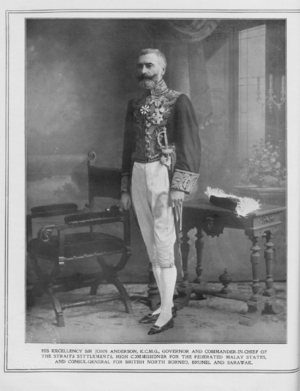John Anderson (colonial administrator) facts for kids
Quick facts for kids
John Anderson
|
|
|---|---|
 |
|
| 16th Governor of the Straits Settlements | |
| In office 15 April 1904 – 9 April 1911 |
|
| Monarch | Edward VII George V |
| Preceded by | Sir Frank Athelstane Swettenham |
| Succeeded by | Sir Arthur Henderson Young |
| 22nd Governor of British Ceylon | |
| In office 15 April 1916 – 24 March 1918 |
|
| Preceded by | Reginald Edward Stubbs (acting) |
| Succeeded by | Reginald Edward Stubbs (acting) |
| Personal details | |
| Born | 23 January 1858 Gartly, Aberdeenshire, Scotland |
| Died | 24 March 1918 (aged 60) Colombo, Ceylon |
Sir John Anderson (born January 23, 1858 – died March 24, 1918) was an important Scottish government official. He worked for the British Empire in different parts of the world. He was the Governor of Ceylon (now Sri Lanka) from 1916 to 1918. Before that, he was the Governor of the Straits Settlements (a group of British territories in Southeast Asia, including parts of modern-day Malaysia and Singapore) from 1904 to 1911.
Contents
Early Life and Education
John Anderson was the only son of John Anderson, who was in charge of the Gordon Mission in Aberdeen, Scotland. He was a very bright student. Before he turned 20, he earned a Master of Arts (MA) degree from Aberdeen University. He was excellent at mathematics and even won a special gold medal that year.
His Career Journey
Two years after finishing university, John Anderson started working for the Colonial Office. This was a government department in Britain that managed its colonies around the world. He began as a clerk, helping with office tasks.
In 1887, he studied law and became a student at Gray's Inn, a famous place for lawyers in London. The next year, he continued his law studies.
Working in Different Places
Sir John traveled a lot for his job. In 1891, he went to Gibraltar with another official, Sir John Frederick Dickson. Their job was to check on the records of the Supreme Court there.
Later, he became a private secretary to Sir Robert Meade. Sir Robert was a very senior official in the Colonial Office. In 1892, John Anderson also worked as the British Agent for the Bering Sea Arbitration. This meant he helped settle a disagreement about fishing rights in the Bering Sea.
Helping the British Empire
From 1883 to 1897, he helped edit the Colonial Office List. This was a publication with information about all the British colonies. He then became a main clerk.
In 1897, he became the secretary for a big meeting. This meeting was between Joseph Chamberlain, a powerful British politician, and leaders from different British colonies. This gave Sir John a great chance to understand how the self-governing colonies felt.
In 1899, he went back to Gibraltar. This time, he looked into how much civil servants there were being paid. He returned to London in the same year.
A Royal Tour
In 1901, something very special happened. Joseph Chamberlain chose Sir John to travel with the Prince and Princess of Wales (who later became King George V and Queen Mary). They went on a famous tour around the British Empire on a ship called HMS Ophir. During this trip, Sir John saw the colony of the Straits Settlements for the first time. He would later become its governor.
In 1902, he again helped organize another Colonial Conference. In 1903, he received thanks from the Canadian Government. He also got a special medal for his help with the Alaska boundary dispute. This was another border disagreement.
Becoming a Governor
In 1904, Sir John Anderson was appointed as the Governor of Straits Settlements. He served in this important role until 1911.
In 1916, he became the Governor of British Ceylon. Ceylon is now known as Sri Lanka. While in Ceylon, he played a big part in solving many problems. There had been riots in 1915, which the British had dealt with very strictly. Sir John worked to bring peace and stability.
His Final Days
Sir John Anderson became suddenly ill in 1918. He was at Queens Cottage in Nuwara Eliya, Ceylon. He passed away on March 24, 1918.
It is said that his chief local assistant, Sir Solomon Dias Bandaranaike, was by his side. Sir Solomon wrote about Sir John's death:
Sir John was the first Governor of this country to die while his term of office in Sri Lanka and was as yet unfinished, and every circumstance combined to make his death a matter of genuine and universal grief so that it seemed almost a personal loss. May our people of Lanka take an example from this Great and Good man!
Honors and Awards
Sir John Anderson received several important honors for his work.
- In 1898, he was made a Companion of the Order of St Michael and St George (CMG).
- In 1901, he became a Knight Commander of the Order of St Michael and St George (KCMG). This happened when he was about to go on the royal tour with the Duke and Duchess of York.
- In 1906, his old university gave him an honorary Doctor of Laws (LL.D.) degree.
His Legacy
Sir John Anderson's name lives on in places he helped govern.
- The Anderson School in Ipoh, Malaysia, was named after him. He was the High Commissioner of the Malay States at the time. The school officially opened on February 6, 1909.
- In Singapore, the Anderson Bridge and Anderson Road were named after him. Anderson Road also gave its name to Anderson Secondary School, which was originally located there.

